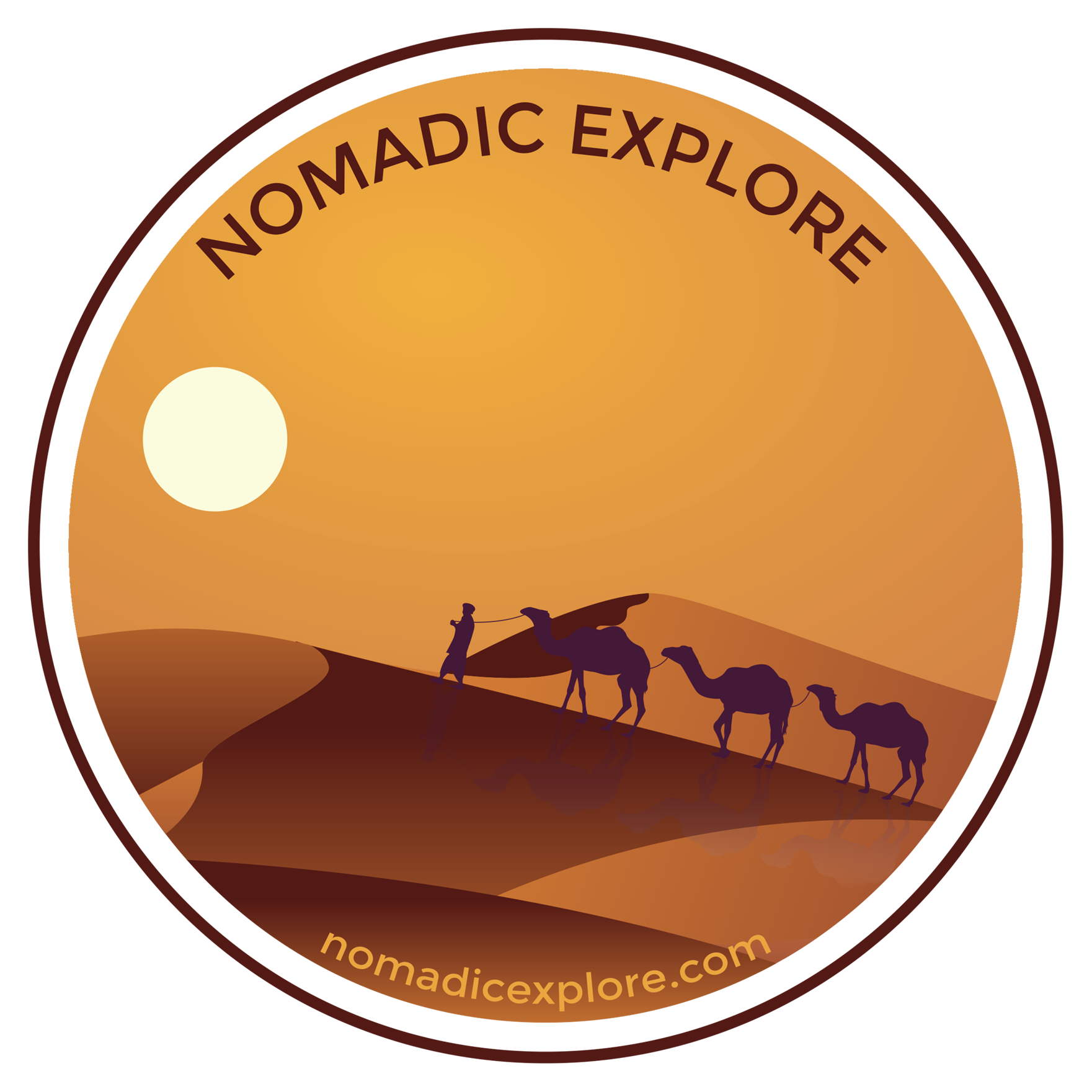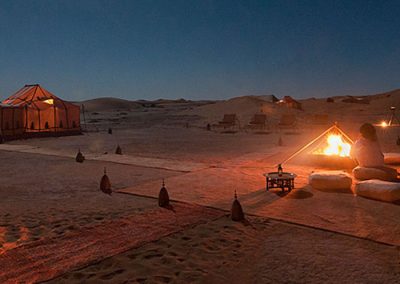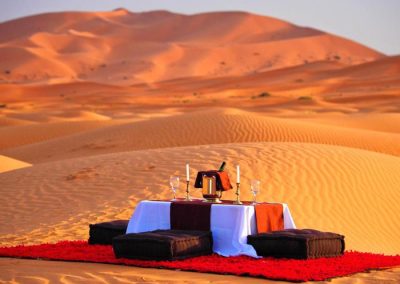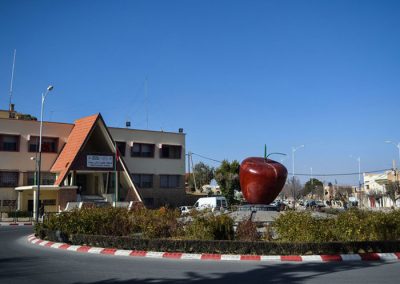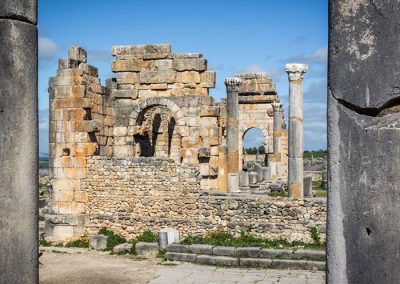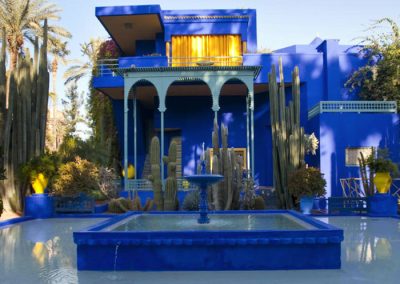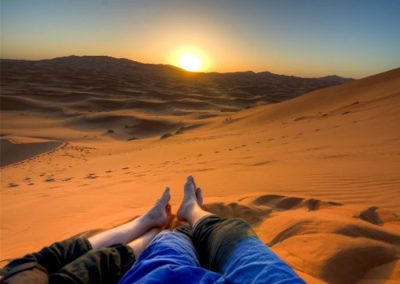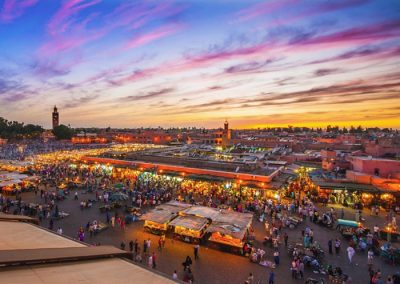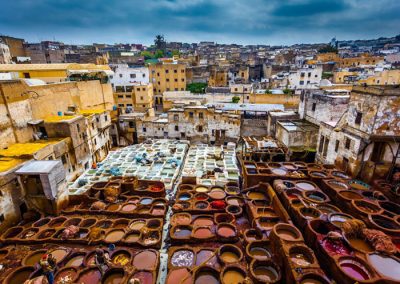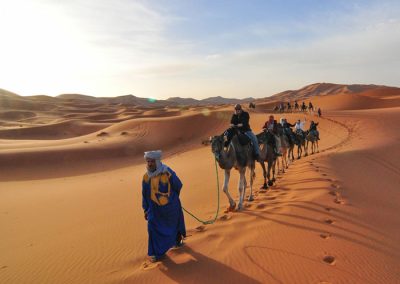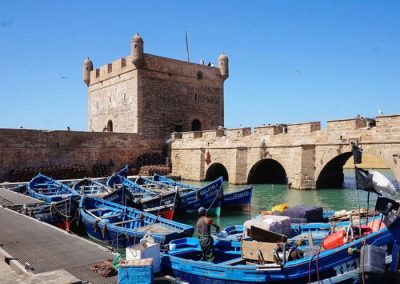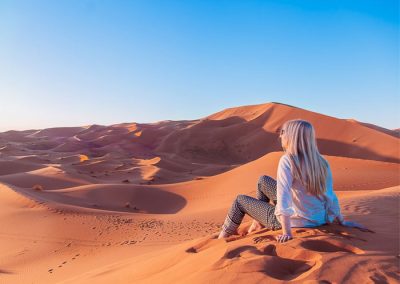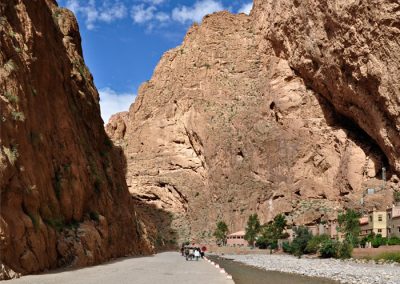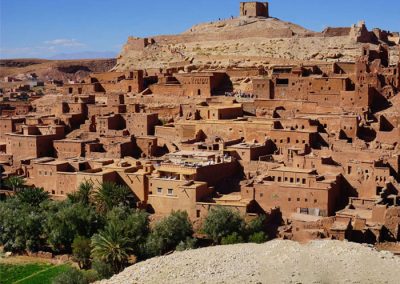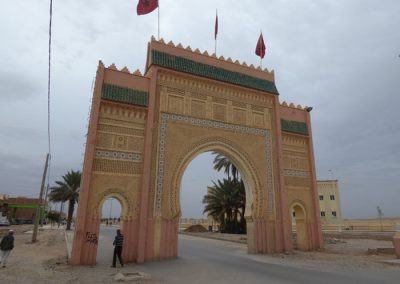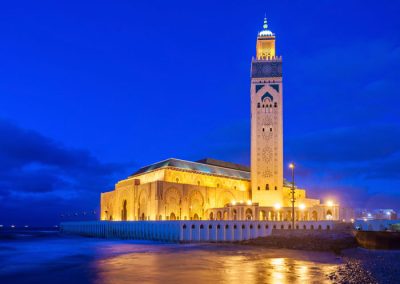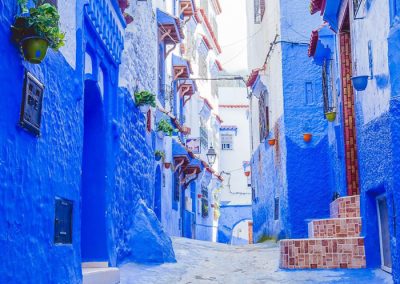10 Days Morocco Imperial cities historical & cultural tour
book this tourItinerary overview
This is a journey of investigating Morocco imperial cities that were ruling Morocco in several past times, in these ten days we will travel around Morocco’s classic destinations passing through its four imperial cities. Over little days, you will rich your knowledge by investigating the striking traditional and historical architecture of the administrative capital of Morocco Rabat, tasting and living with imposing walls and monumental gates of the Capital Ismaailia city of Meknes the capital of kings, find out the mosque of the spiritual and scientific city of Fez watching the tanneries and walking into the markets having ideas about the craftsmen. Travelling via the everlasting climaxes of the high atlas enjoying the beauty of the scenery of Morocco, moving towards the Middle and High Atlas Mountains chains listening to narrators and storytellers, photographing with snakes, painting the traditional henna of Marrakech cheerfulness walking in the historical square of Djemaa el Fna via the way to Marrakech driving to one of the highest desert in Morocco; sahara desert and sand dunes to have fun with Berber people as an example playing drums riding camels …. To walk across the Todra valley gardens to meet and interact with locals before going in time to the Roman Empire at the archaeological site of Volubilis, to discover the delightful Essaouira coastal town. As a result of this calls in which you wonder and highlight, see and live in each part of this journey. It will be one of the unforgotten classic cultural exploit.
Itinerary: Morocco imperial cities tour
DAY 1: FROM CASABLANCA – Rabat
These ten days Morocco imperial cities tour will start from Casablanca as one of the royal and biggest cities in Morocco and the largest one of the Maghreb that situated in the mid-western for more than 90km via the south of the administrative capital of Morocco. We will start first by walking around Casablanca discovering it’s amazing places tasting the fruitful beauty of its traditional architecture beginning by the Old City; an old neighborhood built as the way which the Old Moroccan cities was, surrounded by many walls, and it includes several doors to enter; we mention the most famous one Bab Marrakech which is one of the most important monuments in the city, the only one that still exists after the earthquake that hit the city. We can also have a look to the White Mosque; one of the most touristic attractions in Morocco because it is the largest one in Morocco pulling touristic by its beautiful white color that send a kind of serenity in the soul, and its proximity to the ocean. We can also visit Abdel Rahman Salawi Museum that shows the history of earliest and modern Morocco established in 1940 which is attributed to Abderrahmane Slaoui, a very known Moroccan traveler and explorer, and we can also discover the Hassan 2 mosque that is located directly on the coast nearly to the lighthouse of the neck it was built in 1993, it is considered as the largest spiritual and religious landmark in Morocco, it is chining with its decoration and construction.
From the capital economic, we will move towards the administrative capital of Morocco: Rabat that embrace many monuments worth seeing, as an example the Royal Gates which built in 1864, moving to have an exciting look to the garden of Challa that built between 1310-1330 enjoying its delightful beauty that made up by walls that surround this historical garden with defensive gates. Afterward we will hold at Mohamed V Museum built in 1972 continuing our way to look around the tombs of Moroccan kings Mohammed V who died in 1962 and Hassan II who died in 1999 taking a view also to the grave of Moulay Abdullah the uncle of Mohammed VI finishing our day by visiting Tower Hassan which was built in 12th-century in the time of JACOB the MANSUR period of the ALMOHADS, where this historical parameter was added in the initial list of World Heritage, it is a minaret of an incomplete mosque.
DAY 2: RABAT – CHEFCHAOUEN
We will start the day by exploring the Kasbah of Oudaya which was built in the 12th-century by ALMOHADS also. This fortress was built with an ANDALUSIAN-STYLE, and what make the KASBAH a place worth visiting are the monuments that make it up such us JAMAA AL ATIQ mosque, the military work of BORJ SQALA that served as a military base for the Almorabits army in their defense against the Spanish army, the royal residence of the ALAWIT DYNASTY and the PRINCELY HOUSE erected to the west. The top of the Kasbah offer to you best opportunities to enjoy a striking view of the surrounding area. You will also get to see the 240 km long Abi-Regragriver located in western Morocco between Rabat and Salé. In this way, we will find ourselves finishing Rabat Calls to walk away towards Chefchaouen via the cities of Knetra, and SidiKasem having a break in Ouazaane passing by spectacular scenery with cedar, oak and almond trees.
Chefchaouen a widely appeared city between two climaxes in the charming Rif Mountains bearing in mind the fresh sun lamp that descend among that narrow paths of the city making the blue color sparking and delight. Chefchaouen that was a traffic way between Tetouan and Fez, and served as a base for the curbing of Portuguese, after it was colonized by Spanish in 1920 and. You will observe that Chefchaouen is made up with several building containing striking blue and whitewashed explained by Andalusian refugees escaping the Reconquista who recreated the blue city of Chefchaouen that make the visitor feel as he or she is in Spain due to its red-tiled roofs and artistic doorways which give a sense of tranquility, comfort. Spending the day exploring the sights, sounds, and smells of the medina, the shops in the square selling woven goods and small sweets, and most importantly, tasting the town’s famous goat’s cheese. Herds of goats wander the sparse hillsides that surround Chefchaouen, and their cheese is sold in great fresh rounds in the street markets investigating
what this attractive city abounds to us in monuments. This city contains several ancient districts, such as the KASBAH, SOUIKA…that deserve seeing where you can stroll through the tranquil gardens inside, visit the ethnographic museum, and soak in wonderful views from the rooftop then move to the waterfall of Ras el-Maa to get refreshed before continuing our discovering by driving out of town to enjoy a short hike in the surrounding hills. For dinner, you will be grateful when enjoying Moroccan food in a house cooked full of taste and made with much love.
Morocco imperial tour from Casablanca.
DAY 3: CHEFCHAOUEN – VOLUBILIS – FES
After finishing breakfast, we will slide down from the hill blue city of Chefchaouen voyaging across the south passing the center of the neck of land for about three hours towards the sacred pilgrimage town of Moulay Idriss after reaching Volubilies; a Berber city that is one of the historical monuments in Morocco, shut to Meknes city for more than 25 kilometers. Many civilizations passed by, but ROMAN civilization had a great influence on it and made it one of the World Heritage sites. Honestly speaking there are many attractive things that pull visitors as the great wall with its eight doors and some watchtowers that were built with a ROMAN touch and the high plateau where you can take a walk and a tour around arches, basilicas, and excellent mosaics along the Decumanus Maximus, many of which remain intact. The reward for walking in the sun lies in an unbelievably memorable lunch of traditional Roman recipes in the shadow of the ancient ruins. Recline on Moroccan Kilims and have dinner on local ingredients, much as the Romans did a thousand years ago. Afterward lunch your next stop will be a city located in northern Morocco that was built upon the rocky hills at the base of Mount Zerhoun. It took his name from the founder of the IDRISSID state Moulay Idriss 1, it was forbidden to non-Muslims, (IF TIME PERMITS). The city of Molay Driss Zerhoun tenders to you a large insight toward traditional Moroccan life. At a religious place where the great-grandson of Mohammed and the man who brought Islam to Morocco, the faithful gather to pay homage at the tomb here searching the delightful streets, perhaps sampling the famous nougat candy sold at street-side stalls. Before moving to Fez, the spiritual heart of Morocco for the night.
Go in-depth into Morocco imperial cities by planning your tour with us.
DAY 4: EXPLORE FES
Fes is one of the Morocco imperial cities. Following breakfast in the scientific capital and the spiritual city of Fes, the second largest city of Morocco that was a center of the Jewish community during the past historical times, explained by the old city of Fez el Bali that is possible may be defined as the greatest of all Medinas and by its situation and pictured alleyways modifying by the move of donkeys piled high with goods that show the exists and the stills of traditional life that is hugged between Fez’s people, also the air perfumed by spices; it kicks us back through times to the Middle Ages. In addition, due to the guide that our premium local tour offered to you, you will decorate your eyes with the artisans’ creations that adorned the narrow streets, to rich your knowledge about tanneries and how Morrocan makes leathers, visit mosques and colorful local authentic Moroccan architectural characters. Going and investigating the dissimilar specialty places of the Center of the city enjoying typically food made up of naturally butters and fats, taking pleasure in tasty pastries, to crepes and soups to dried and fresh produce. Fez was established by Idris 1 in the twelfth century and was for known for a long time to be the social capital and focal point of the Almohad it is currently a World Heritage site according to UNESCO classification because it embraces many monument places worth seeing as the old city, known locally as Fes el Bali, it’s an attractive charming place, a place that is debatably one of the world’s most captivating old city. Fez was being for a long time as an educational center for people that have diverse nationality, it was the point where many cultures were intermixed especially at the University of AL –Karaouine the oldest in the region and in the world according to UNESCO where we find mosques of great renown that was a place for pray and also as a library and religious institutions. Walking around the specialty zone that divides the souk, filled with historic khans, madrassas, and dye-pits, stalls overloaded by fruits, herbs, and soups, and where the squawk of chickens, smells of spice. Spend the day exploring the old city by discovering the best school ever of studying Islam, the BOUANANIA SCHOOL built during the reign of the MARINIDS, a witness of the MARINIEN architecture in Morocco moving towards the TANNERY as well, so FEZ is famous on producing leathers, we find that the TANNERIES of SHWARARA is one of the famous ones in FEZ before going to the splendid Funduk Nejjarine, a beautifully restored 18th-century inn. Return to your hotel in the late afternoon and enjoy an unforgettable dinner of one of the city’s signature dishes, the salty and sweet pastille. Car : 1 hour – Walk : 3 hours /
DAY 5: FES – MIDELT – ZIZ VALLEY – ERFOUD – MERZOUGA SAHARA
From the Morocco imperial cities to the Sahara desert. When finishing our Fez’s calls we will take a long way driving via the Atlas Mountains towards the most modern and clean city in Morocco named Ifran. IFRANE means caves in AMAZIGH famous as Switzerland of Morocco. It attracts many visitors with its waterfalls, green nature, and European character they may come skiing because of its high altitude at 1665 meters or they may come to sniping. Our exciting trip continues, but this time across the Cedar forest, the largest woods in Morocco at the Middle Atlas, for about 89km south of the city of Fez driving towards Midelt where we are going to have a Berber lunch at this Berber village that is situated on the foothills of the eastern part of the High Atlas Mountains. From the vast plateau, we start passing those tough mountains which are still established by a big Berber community. The landscapes here include palm tree Oases at JbelAyachi (at 3747 m) continuing our way to visit the monstrous Tiz Ntalghamt pass and the Ziz Gorge, amused by the view of the High Atlas Mountains viewing Tafilalt Oasis until we reach the city of Errachidia where you will watch colossal palm trees and a location perfect for building up an extensive variety of natural item trees and vegetables with a one of a kind microclimate. Moreover, we will pass through the rich Ziz Valley, stopping at various stations to relish the view and take pictures en route to Erfoud and Rissani; ERFOUD the capital city of fossils that organize the DATES SEASON yearly and were a sea before hundreds of years. Heading up to the red-colored sand sea dunes of Erg Chebbi at Merzouga via, RISSANI, Sijilmassa once upon a time the hometown of the Alaouist dynasty, where Moulay Ali sheriff started to unify Morocco under his red flag at the beginning of the 17th century before continuing the way to Merzouga that his huge sand dunes appearing from the horizon. By arriving, we will be welcomed by a glass of mint tea followed by one hour and a half of riding on a camel guided by a specialist camels man in the desert to spend a wonderful night enjoying these dramatic dunes, wonderful skies, and stars at night, you may want to experience Berber Gnawa music playing drums with them while rounding campfire at that night dinner will be served in the campsite.
DAY 6: MERZOUGA – RISSANI – TODGHA GORGES – DADES GORGE
Another day in the desert before leaving for another Morocco imperial city. Waking up early eating breakfast by the time when the sun colored Merzouga with its gold color making it a garden of golden sand following that by a drive towards Errisani the capital of sijilmassa heading up to the Mausoleum of Moulay Ali Charif the founder of the Alawite Dynasty of Morocco during the 17th century. This fantastic town was the capital of Tafilalt as the center point between north and south brought the city to an important status of a former major caravan center. To the present time, Errisani stays as a main commercial center in the region, with a big souk where you can find everything you want, especially on Sunday; however of having two other days Tuesday and Thursday. Errisani is famous for selling dates, ships, and goats in particular ancient times.
Driving away from Errisani customary Moroccan town with the mainstream of the women disguised and men hooded towards the immense canyons of Morocco Todgha Gorges for about 127km. Todgha Gorges are situated ahead of the central high Atlas Mountains where you will see the contrasting landscapes take you back of Colorado, with its high plateau, its gorges, and great canyons, and its peaks sometimes fractured by erosion. Todgha Gorges are natural monuments in the southeastern that were crafted by Todgha Valley and Dades Valley over thousands of years. It attracts lovers of Mountain tourism where they can climb several peaks such as Jbel Saghro with 2500m and several peaks exceeding 4000m as JbelMgouna with more than 4000m being the highest in this part of the High Atlas.
Driving away from Todgha Gorges towards Dades Gorges via the road of 1000 Kasbahs. However, of the excising of enormous ones of both sides of the route we find that many old fortified houses are restored but unfortunately, lot of them are ruins. Now we reach Dades Gorges or Valley observing the natural creativity of the rock development and formations called “the monkey toes” and we head to the Berber family for Lunch, a cooking course, a walk to discover the valley, and spend some time with the Berbers before we head to our hotel near the valley. Overnight in Roses valley.
DAY 7: DADES GORGE – AIT BENAHDDOU – MARRAKECH
From the charming Dades Valley driving via the high Atlas Mountains through Boumalen, that alive with big Berber community and its agriculture; continuing our way along Roses Valley that is partly appearing from the horizon enjoying the charming beauty of the nature, towards KALAA MGOUNA that is famous on producing flower and rose water, also it is known on organizing the competition of the Miss QUEEN of flowers and to rich our knowledge about the local productions as soap, perfumes and skin creams arriving to Ouarzazate the gateway to the desert, a city that established in 1920, situated in the middle of a bare plateau, south of the High Atlas Mountains that is populated by Berbers who constructed many of the prominent kasbahs and building for which the area is known as the Kasbah of Taourirt diverted in 17th century. The door to the desert is known as Hollywood Africa where many famous movies were filmed there in one of Morocco’s biggest studios inviting many international film companies to shoot their movies like Lawrence of Arabia (1962), The Living Daylights (1987), The Last Temptation of Christ (1988), The Mummy (1999), Gladiator (2000), Kingdom of Heaven (2005).
From the Hollywood of Africa to the fortified city of AïtBenhaddou, built in the 11th century it is classified as a World Heritage site since 1987 and several movies have been filmed there. A collection of several traditional buildings and fortified house side by side is located on a hill along Ounila River that it was the former caravan route between the Sahara and Marrakesh for several past times. Finally, we will go towards the High Atlas Mountains enjoying its panoramic views, and the invention of green nature seeing Berber towns along the way about a few hours’ drives until we reach Marrakech; it is called the “Homeland of God in Berber” where we will spend the night in a traditional riad close to the medina.
DAY 8: MARRAKESH, FULL GUIDED CITY TOUR
Here you are in Marrakech in one of the Morocco imperial cities; you will have a full day exploring the Red City of Morocco with our local guide. Historically speaking Marrakech is one of the previous royal cities in Morocco. Marrakech, which is known of being seven men, is a city of special magic that is located near the foothills of the snow-capped Atlas Mountain. Like all the old cities, Marrakech contains both an old fortified city The Medina, and a very modern city called Gueliz established during the French occupation. Marrakesh has the largest captivating traditional souks( native markets ) it is the town’s star attraction you mustn’t miss the Babouche (shoes) Souk, Chouari (carpenter’s) open-air market, El-Attarine (perfume and spice) souk, and the Cherratine (leather) souk before heading up to the busiest squares in Africa and the world, Djemaa el Fna. The square is full of storytellers, water sellers, dancers, snake charmers, and musicians. During the night, the square turns into a huge open-air restaurant. We will also visit the KOUTOUBIA Mosque, built in the 12th century in the period of influence of the Almoravid Dynasty. We will go among narrow streets and allies in the ancient city and we may want getting around the back streets of the old town enjoying talk with the MARRAKECH people; they are too funny and humble. We pass by “seven saints” during the reign of Moulay Ismail, the festival of the seven saints was founded to the request of the Sultan. The tombs of several renowned figures were moved to Marrakesh to attract pilgrims. In addition, you may want to visit the Majorelle Garden which contains a blue villa with flowers of different types; the French painter Jacques Majorelle gave it as a gift to Marrakech which was dominated in the first half of the 20th century by T’hami El Glaoui, “Lord of the Atlas”, and Pasha of Marrakesh. Still, there is a house called Dar Pacha El Glaoui from where he used to rule the completely southern part of Morocco.
DAY 9: ESSAOUIRA DAY TOUR
Driving from Marrakesh to Essaouira you will see in your way the enormous Argan tree on both sides of the road. These Argan trees are frequently climbed by goats. To eat and food, these trees are the sources of making Argan Oil which is produced by several women’s cooperatives and is used to prepare couscous and salads. Moreover, it was traditionally used as a treatment for skin diseases before being founded as good enough for cosmetics by European manufacturers. Still stopping by one of these cooperatives is worth seeing how Berber women squeezed the Argan fruits between their hands to extract this precious oil. When we reach our region in this nine-day, we will explore the city of Essaouira which is well known for its kite surfing and windsurfing, with the powerful trade wind so that it is called “the city of the wind” .Horse riding, camel riding along the beach, and quad biking are activities that one can enjoy while staying in Essaouira. It was inhabited by ancient civilizations such as the ROMANS, and PORTUGAL, and its 18th-century seaport fortress – is a UNESCO World Heritage. ESSAOUIRA offers you many monuments to see and discover, such us; AL RAMALLAH also known as the Jewish Quarter or the merchants of the sultan, you will be grateful when our guide takes you to the ISLAND of MOGADOR small island located near the city, it is one of the most important Phoenician sites.
You can enjoy the festival of “Gnawa music” that is organized since 1998, where several singers from around the world come from diverse places to participate in this festival that is scheduled in the last week of June that includes rock, jazz, and reggae musicians. That day you may have lunch in a very Moroccan manner, or u can have a gridiron of fish because Essaouira is famous for seafood. In the late afternoon, you may want to have a walk and explore by yourself and sit to feel the romantic magic of town, and u may choose to walk on Moulay el HASSAN Square which has an attractive location overlooking the Atlantic Ocean, the sunset there casts in the self a sense of love, romance, and tranquility. We can. In the evening, we will take the way going back to Marrakech. And if time helps we can have a walk in this cheerful city.
The best thing about this tour of Morocco imperial cities is that you will enjoy while you’re learning about the history and the culture of Morocco.
DAY 10: CASABLANCA / AIRPORT TRANSFER
It is the last day of the tour of Morocco imperial cities after breakfast. You may have some free time to explore by yourselves before the time of the private airport transfer you will be advised of the pick-up come. We can add more accommodation if you wish to spend more time exploring here.
Contact us for more information on this tour of Morocco imperial cities.
What is included
- Private A/C Vehicle or Minivan (plus fuel)
- English/Spanish/French speaking driver during the tour
- Pick up & Drop off at your accommodation
- Accommodation with evening meals & breakfasts
- Camel Trek to overnight in nomad desert or luxury camp (Private tents)
- explore volubilis
What is not included
- Flights
- Drinks
- Lunches
